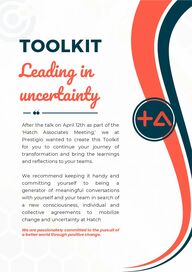
Return to flip book view
TOOLKITLeading in uncertaintyAfter the talk on April 12th as part of the'Hatch Associates Meeting,' we atPrestigio wanted to create this Toolkitfor you to continue your journey oftransformation and bring the learningsand reflections to your teams.We recommend keeping it handy andcommitting yourself to being agenerator of meaningful conversationswith yourself and your team in search ofa new consciousness, individual andcollective agreements to mobilizechange and uncertainty at HatchWe are passionately committed to the pursuit ofa better world through positive change.
Toolkit Hatch + PrestigioHERE YOU WILL FIND:A context graph: “We are not in an era of change. We arein a change of Era” - From the Industrial Age to theDigital AgeHatch is distinguished by its dedication to finding innovativesolutions that transform the world for the better. By mergingPrestigio's experience and vision with Hatch's values and mission,we hope to provide valuable guidance that inspires andstrengthens leadership at all levels of the organization. Together,we are prepared to embrace the challenges of tomorrow and leadthe way to a stronger, more secure future.INTRODUCTION5 New tools to lead a VICA (volatile, uncertain, changingand ambiguous) context with a positive attitude.Some questions so that you continue reflectingindividually and take them to your team.Images of 4 conceptual frameworks that Hatch hasdeveloped for you and that have a lot of value for yourdaily life:Hatch ManifestoLeadership at HatchMindset in Hatch (upper right quadrant)Emotional intelligence in Hatch.
Toolkit Hatch + PrestigioTHE CONTEXTAccelerating ChangeWe are facing a wonderful, vigorous era full of possibilities. However,the speed of the pace of change has generated a VICA (volatile,uncertain, changing and ambiguous) context. Due to the above,Leadership and emotional awareness become key success factors toturn challenges into progress.PREMISESTo close this gap, we only have one solution: put technology at theservice of BEING and not the other way around. We must increase ourcapacity to make our own decisions, to build extraordinary results fromindividual and collective well-being, and look at change with a newperspective, one that allows us to differentiate the technical and theadaptive, and that invites us to use our most powerful weapon:consciousness and our ability to learn.Leadership from the BEING
Toolkit Hatch + PrestigioNOPRUDENCEYESNONSENSETOOL 1Transform fear into courage- emotionalawarenessFEAR YES RESOURCESPurposeValuesAdaptabilityResilienceCONFRONTCONFRONTNOYESNOCOURAGEFEARFULNESSI AM SCARED?DO I FACE IT?Do you have the capabilities toface change and overcome fear?Follow this decision treeindividually or with your team,when something scares you.YES
Toolkit Hatch + PrestigioTOOL 2Distinguishing the nature of the challengeTECHNICAL WORK VS. ADAPTIVE WORKTECHNICALCHALLENGEADAPTIVECHALLENGEThe problem is known(previous experience)The problem and/orsolution are not knownThe solution is known(prior experience)The group has establishedprocesses and people responsibleto provide the solutionNo need to learnThe solution exists beforethe problemNo expert knowledgeavailableThere are no defined processesor responsible parties that candeal with the problemThe problem and/orsolution are not knownThe problem and/orsolution are not knownImprove decision making: By understanding the nature of the problem,more informed decisions can be made about how to address it.Allocate resources effectively: Resources can be assigned to the areasthat need them most.Increase the chances of success: By using the right approach, youincrease the chances of success in addressing the problem.Benefits of using the tool:
Toolkit Hatch + PrestigioTOOL 3Provoke mobilizing conversationsTrench debate Reinforcing past patternsEquilibriumImbalanceOpening possibilities for the futureMobilizing dialoguePolitically correctReflective dialogueAction: Attacking the problem and seekingblameEmotion: angerResult: insult, blame, mistreatAction: Hide the problemEmotion: denialResult: evasion, omission, sabotageAction: Proactivity with purposeEmotion: Confidence and sense of purposeResult: Solve problemsAction: “False respect” and minimize theproblemEmotion: DisempoweringResult: justify and rationalizeSTRAINCONTAINMENTKNOWN AREAPANIC ZONEZONE OF UNCERTAINTY
Toolkit Hatch + PrestigioWE RESIST CHANGE, WE RESIST LOSSESPREMISETOOL 4The Change CurveWhen change involves 'losses,' it naturally evokes legitimate andhuman resistance. Understanding this process, bringing it toconsciousness, and collectively working through each stage arevital steps to accelerate the change process.Call toadventureEnd of the adventureDenialFearDesert crossingWe create a new reality andnew habits0. External or Internal?1. Adjustment of expectations in the face of reality 2. Listening and empathy in the face of losses3. Purpose4. Awareness of autopilots5. Understanding and emotionalmanagement6. Co-creation of change7. Importance of early victories8.Coherence and example9. Conscious learning What did it cost us and why?10.Celebration, recognition andpride. We are ready for the “newadventure”How can we take advantage of“early wins” in the changeprocess to maintain long-termmomentum and motivation?
Toolkit Hatch + PrestigioTOOL 5The Challenge + The Role + The BeingHow can we develop an organizational culture thatencourages systems thinking and proactive action at all levels,from the individual to the organization as a whole?
Toolkit Hatch + PrestigioCONCLUSIONSWe invite you to:Learning to Pause: "Getting on the Balcony" a. Observe: Facts, data, and "automatic" inconsistent behaviors b. Interpret: The nature of the challenge: Are we facing a technical oradaptive challenge? Managing losses: We are not resisting change; we are resistingreal or subjective losses. c. Intervene: Infuse purpose and Hatch values Leading from BEING withemotional awarenessTeamwork challenges: Do you distinguish between technical and adaptivechallenges? - Tool 11.What quadrant are conversations USUALLY in on your team?2.When you feel fear (emotion), do you usually have: Courage,cowardice, prudence, or foolishness?3.Do you use the leadership tools that Hatch has given you inyour daily life? 4.Watch the conversation with Alex Roviraat the Prestigio Leadership Live 2024.”Learn to live better -Álex RoviraClick here
Toolkit Hatch + PrestigioTOOLSManifest:Leadership:
Toolkit Hatch + PrestigioTOOLSConsciousness: What is my usual attitude?CDM: Emotional Intelligence Model
www.prestigio.com.coPrestigio Liderandodesde el serprestigio.laComunidad PrestigioLatam - Liderando desdeel SER